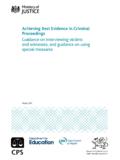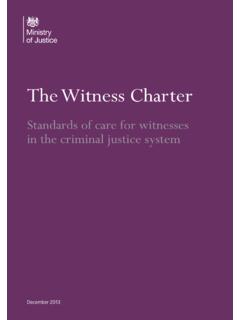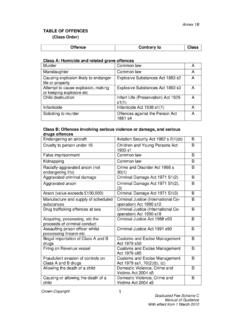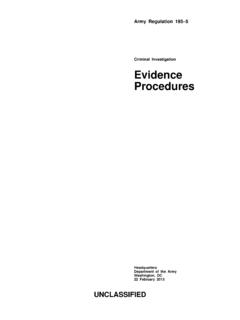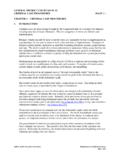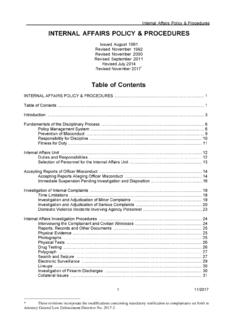Transcription of Achieving best evidence in criminal proceedings - cps.gov.uk
1 Achieving Best evidence in criminal proceedings Guidance on interviewing victims and witnesses, and guidance on using special measures March 2011. Achieving Best evidence in criminal proceedings Guidance on interviewing victims and witnesses, and guidance on using special measures Alternative format versions of this report are available on request from 020 3334 6078 or Contents Achieving Best evidence in criminal proceedings Contents Foreword 1. 1. Introduction 3. Status 3. Scope 3. Vulnerable and Intimidated Witnesses (eligible for Special Measures) 4. Vulnerable Witnesses 4. Intimidated Witnesses 5. Special Measures 6. Significant Witnesses (not eligible for Special Measures) 8.
2 Training 9. 2. Planning and preparation 10. The Importance of Planning 10. Initial Contact with Victims and Witnesses 10. Competence, Compellability and Availability for Cross-Examination: the Legal Position 11. Planning Information 13. Overview 13. Child Witnesses 14. Definition 14. Preliminaries 14. The Context of the Allegation: the Intersection of the Child Protection and criminal Justice Systems 14. Consent 17. Informing the Child's Carers 19. Medical Examinations 20. Psychiatric/Psychological Assessment Interviews 21. Information about Child Witnesses 21. Previous Interventions 23. Race, Gender, Culture and Ethnic Background 24. Other Life Experiences 25. Assessment Prior to the Interview 27.
3 Vulnerable Adults 28. Definition 28. Preliminaries 29. Recognising Vulnerable Adult Witnesses 29. Support for Vulnerable Adult Witnesses 30. Consent 34. i Achieving Best evidence in criminal proceedings Contents Information about Vulnerable Adult Witnesses 36. Race, Gender, Culture and Ethnic Background 37. Other Life Experiences 38. Witnesses with a Significant Impairment of Intelligence and Social Functioning (Learning Disability) 39. Witnesses with a Physical Disability 41. Witnesses with a Mental Disorder 41. Intimidated Witnesses 41. Definition 41. Preliminaries 42. Support for Intimidated Witnesses 42. Presenting the evidence of Intimidated Witnesses 42. Information about Intimidated Witnesses 43.
4 Significant Witnesses (not eligible for Special Measures) 43. Definition 43. Presenting the evidence of Significant Witnesses 44. Information about Significant Witnesses 45. Hostile Witnesses 46. Race, Gender, Culture and Ethnic Background 46. Information about the Alleged Offence(s) 47. Information Important to the Investigation 48. Information Important to the Investigation Relating to General Investigative Practice 49. Information Important to the Investigation Relating to Case-Specific Material 49. Significant Evidential Inconsistencies 50. Significant Evidential Omissions 51. Use of Planning Information 53. Overview 53. Objectives 53. Techniques 53. How the Interview is to be Recorded 54.
5 Interviewers and Others Present at the Interview 56. The Interviewer 56. The Interview Monitor 57. Equipment Operators 57. Interpreters 57. Intermediaries 59. Interview Supporters 60. Location of the Interview 61. Timing of the Interview 62. Duration of the Interview (including Pace, Breaks and the Possibility of more than One Session) 62. ii Contents Achieving Best evidence in criminal proceedings Victim Personal Statements 63. Planning for Immediately after the Interview 64. Witnesses who might become Suspects 64. Recording the Planning Process 64. Preparing the Witness for an Interview 64. 3. Conducting the interview 68. Introduction 68. Phase One: Establishing Rapport 70. Preliminaries 70.
6 Neutral Topics 70. Ground Rules 71. Oaths and the Importance of Telling the Truth 72. Child Witnesses 72. Certain Vulnerable Adult Witnesses 73. Phase Two: Free Narrative Account 74. Initiating a Free-Narrative Account 74. Supporting a Free-Narrative Account 74. Compliance 74. Acquiescence 75. Reticence 75. Phase Three: Questioning 76. General Approach 76. Interview Structure 76. Types of Questions 78. Open-Ended Questions 78. Specific-Closed Questions 78. Wording of Specific-Closed Questions 79. Forced-Choice Questions 80. Multiple Questions 80. Leading Questions 81. Summaries 82. Inconsistencies 82. Special Considerations: Children and Vulnerable Adult Witnesses 82. Phase Four: Closing the Interview 85.
7 Recapitulation 85. Closure 85. Evaluation 86. Evaluation of the Information Obtained 86. Evaluation of Interviewer Performance 86. Post-Interview Documentation and Storage of Recordings 87. ROVI 87. iii Achieving Best evidence in criminal proceedings Contents Chronological Investigative Summary 87. Certification 87. Written Statement: Interviewers 88. Written Statement: Significant Witnesses 88. Storage 88. Early Special Measures Discussions 88. Pre-Trial Discussions with Witnesses about Special Measures 89. General Guidance on using Drawings, Pictures, Photographs, Symbols, Dolls, Figures and Props with Children 89. Using Drawings 91. Using Pictures, Photographs, and Symbols 92.
8 Using Dolls, Figures and Props 92. Special Interviewing Techniques 93. The Cognitive Interview 93. The Structured Investigative Interview Protocol 93. Other Interviewing Techniques 94. Further Interviews 94. Identification Procedures 95. Therapeutic help for Child, Vulnerable Adult and Intimidated Witnesses 95. Safeguarding Intimidated Witnesses 96. Witnesses who become Suspects during the Interview 98. 4. Witness support and preparation 99. Introduction 99. Overview of Support and Preparation Work 101. Entitlement to Support and Preparation 101. Nature of Support and Preparation 102. Support at the Investigative Interview 105. Pre-Trial Support 105. Support while Giving evidence 106.
9 Evidential Boundaries 106. Who Can Provide Support? 107. What Skills are Involved? 108. Identifying and Responding to the Needs and Wishes of Witnesses 108. Preparation, Support and Liaison throughout the Court Process 110. Support during the investigation 111. Special Requirements 111. Pre-Trial Support, Preparation and Liaison 112. Communication between the Police and the CPS 113. iv Contents Achieving Best evidence in criminal proceedings Support before the Trial/Hearing 115. Plea and Case Management Hearing (PCMH) 115. Preparation for going to Court 116. A Pre-Trial Visit to the Court 116. Refreshing the Memory of the Witness 117. Communication with the Witness 118. Provision of Therapy prior to a criminal Trial 119.
10 Plans and Communication Concerning the Trial 120. Role of the Witness Service 121. Role of the Courts 121. Meeting the Legal Representative 122. Meeting the Judge 122. Support at the Hearing 122. Planning for Breaks in the Testimony 123. Interpreters and Intermediaries 123. Special Provisions for Children 124. Special Provisions for Vulnerable and Intimidated Adult Witnesses 128. Vulnerable Adults 128. Intimidated Adults 129. Afterwards Dealing with the Outcome 130. 5. Witnesses in Court 131. Introduction 131. The Court's Responsibilities towards Witnesses 133. The Address of the Witness 135. The Responsibilities of Legal Representatives towards Witnesses 135. Competence and Capacity to be Sworn 136.
